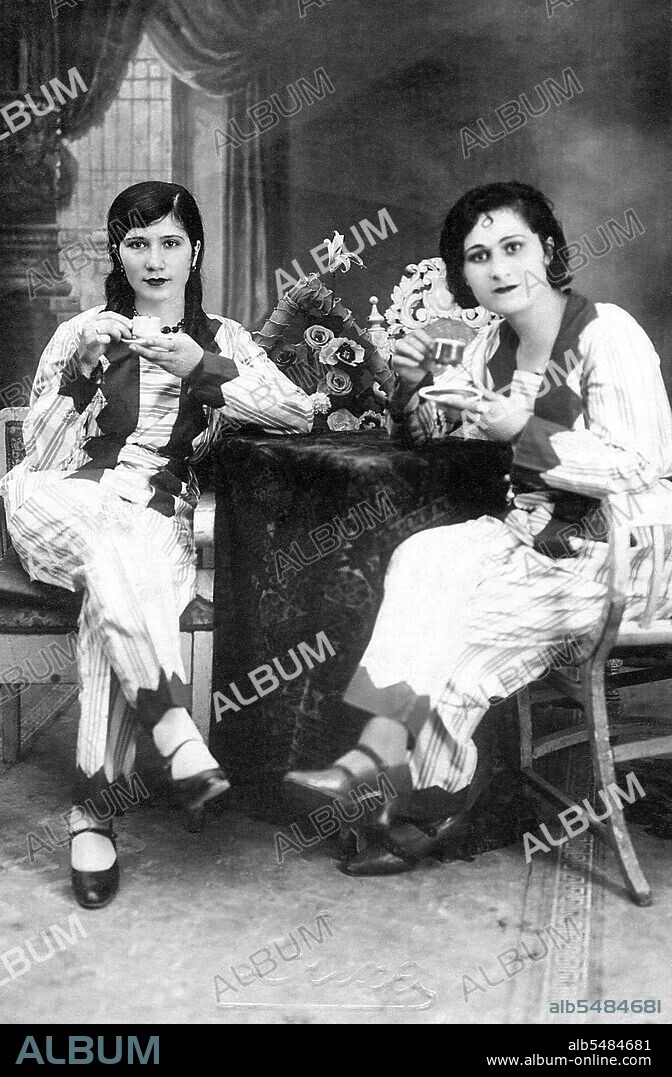alb5484681
Turkey: Two very modern young well-to-do women from Kemal Ataturk's Turkish Republic, c. 1935

|
Añadir a otro lightbox |
|
Añadir a otro lightbox |



¿Ya tienes cuenta? Iniciar sesión
¿No tienes cuenta? Regístrate
Compra esta imagen

Título:
Turkey: Two very modern young well-to-do women from Kemal Ataturk's Turkish Republic, c. 1935
Descripción:
Traducción automática: La República de Turquía fue creada tras el derrocamiento del sultán Mehmet VI Vahdettin por el nuevo Parlamento Republicano en 1922. Este nuevo régimen asestó el golpe de gracia al Estado otomano que había sido prácticamente borrado de la escena mundial tras la Primera Guerra Mundial. La historia de la Turquía moderna comienza con la fundación de la república el 29 de octubre de 1923, con Mustafa Kemal (Atatürk) como su primer presidente. El gobierno se formó a partir del grupo revolucionario con sede en Ankara, dirigido por Mustafa Kemal Atatürk y sus colegas. La segunda constitución fue ratificada por la Gran Asamblea Nacional el 20 de abril de 1924. Durante los siguientes 10 años, el país vivió un proceso constante de occidentalización secular a través de las reformas de Atatürk, que incluyeron la unificación de la educación; la discontinuación de títulos religiosos y de otro tipo; el cierre de los tribunales islámicos y la sustitución del derecho canónico islámico por un código civil secular inspirado en el de Suiza y un código penal inspirado en el Código Penal italiano; reconocimiento de la igualdad entre sexos y concesión de plenos derechos políticos a la mujer el 5 de diciembre de 1934; la reforma lingüística iniciada por la recién fundada Asociación de la Lengua Turca; sustitución del alfabeto turco otomano por el nuevo alfabeto turco derivado del alfabeto latino; la ley de vestimenta (el uso de velo y fez estaba prohibido); la ley de apellidos; y muchos otros
The Republic of Turkey was created after the overthrow of Sultan Mehmet VI Vahdettin by the new Republican Parliament in 1922. This new regime delivered the coup de grâce to the Ottoman state which had been practically wiped off the world stage following the First World War. The history of modern Turkey begins with the foundation of the republic on October 29, 1923, with Mustafa Kemal (Atatürk) as its first president. The government was formed from the Ankara-based revolutionary group, led by Mustafa Kemal Atatürk and his colleagues. The second constitution was ratified by the Grand National Assembly on April 20, 1924. For the next 10 years, the country saw a steady process of secular Westernization through Atatürk's Reforms, which included the unification of education; the discontinuation of religious and other titles; the closure of Islamic courts and the replacement of Islamic canon law with a secular civil code modeled after Switzerland's and a penal code modeled after the Italian Penal Code; recognition of the equality between the sexes and the granting of full political rights to women on 5 December 1934; the language reform initiated by the newly founded Turkish Language Association; replacement of the Ottoman Turkish alphabet with the new Turkish alphabet derived from the Latin alphabet; the dress law (the wearing of veil and fez were outlawed); the law on family names; and many others.
Crédito:
Album / Pictures From History/Universal Images Group
Autorizaciones:
Modelo: No - Propiedad: No
¿Preguntas relacionadas con los derechos?
¿Preguntas relacionadas con los derechos?
Tamaño imagen:
3349 x 5100 px | 48.9 MB
Tamaño impresión:
28.4 x 43.2 cm | 11.2 x 17.0 in (300 dpi)
Palabras clave:
ASIA • ASIATICO • DERECHOS DE LA MUJER • ESTILO • FEMINISMO • HISTORIA • HISTORICO • KEMAL ATATURK • MODA • MUJER • MUJERES • MUSTAFA KEMAL • TURCO • TURQUIA
 Pinterest
Pinterest Twitter
Twitter Facebook
Facebook Copiar enlace
Copiar enlace Email
Email
